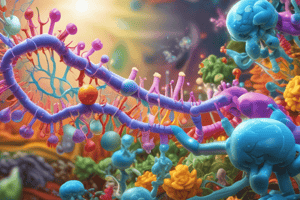Podcast
Questions and Answers
What is the primary function of the large 60S subunit in the process of translation?
What is the primary function of the large 60S subunit in the process of translation?
- To synthesize the polypeptide chain (correct)
- To recruit the small ribosomal subunit and tRNA
- To bind to the 5' end of the mRNA strand
- To read the mRNA nucleotides in groups of three
What is the purpose of the P site on the ribosome?
What is the purpose of the P site on the ribosome?
- To hold a tRNA that carries a growing polypeptide (correct)
- To bind to the mRNA codons
- To release the completed polypeptide chain
- To accept an incoming tRNA bound to an amino acid
What is the result of the elongation step of translation?
What is the result of the elongation step of translation?
- The initiation of transcription
- The recruitment of the small ribosomal subunit
- The formation of a peptide bond between amino acids (correct)
- The separation of the ribosome from the mRNA strand
What is the purpose of the anticodon on the tRNA?
What is the purpose of the anticodon on the tRNA?
What is the function of the stop codon in the mRNA?
What is the function of the stop codon in the mRNA?
The small 40S subunit of the human ribosome contains a 28S RNA with 4700 nucleotides.
The small 40S subunit of the human ribosome contains a 28S RNA with 4700 nucleotides.
During translation, the tRNA carrying the first amino acid in the protein is always bound to the amino acid methionine (Met).
During translation, the tRNA carrying the first amino acid in the protein is always bound to the amino acid methionine (Met).
The ribosome travels along the mRNA strand from the 3' end to the 5' end during elongation.
The ribosome travels along the mRNA strand from the 3' end to the 5' end during elongation.
The E site on the ribosome is where the tRNA binds to the codon on the mRNA.
The E site on the ribosome is where the tRNA binds to the codon on the mRNA.
The sequence of amino acids in the polypeptide chain is determined by the sequence of codons in the tRNA.
The sequence of amino acids in the polypeptide chain is determined by the sequence of codons in the tRNA.
Flashcards are hidden until you start studying
Study Notes
tRNA Structure and Function
- tRNA is a single-stranded molecule with bases U, A, C, and G.
- It has two attachment sites: one for amino acids and one for anti-codons.
- tRNA acts as an adapter molecule, linking amino acids to their specific codons in mRNA.
- Aminoacylation of tRNA is the first step in protein synthesis.
- tRNA is specific to each amino acid.
Ribosome Structure
- Prokaryotic (bacterial) ribosomes have a sedimentation constant of 70S (2.7×10^6 Daltons) with small subunit 30S and large subunit 50S.
- Eukaryotic ribosomes have 80S ribosomes (4×10^6 Daltons) with small subunit 40S and large subunit 60S.
- Ribosomes have two subunits: small and large.
Protein Synthesis (Translation)
- Translation is the process of converting mRNA into an amino acid chain.
- DNA stores the information for proteins in its nucleotide sequence.
- There are three steps to translation: initiation, elongation, and termination.
Initiation
- The small subunit of the ribosome attaches to the 5' end of the mRNA strand.
- The small subunit reads the mRNA nucleotides in groups of three (codons) until it runs into the start codon (AUG).
- The ribosome recruits the large ribosomal subunit and the transfer RNA (tRNA).
- Key ingredients for translation to start: ribosome, mRNA with codon, and tRNA carrying the first amino acid (methionine).
Elongation
- The complete ribosome travels along the mRNA strand and reads the nucleotides in groups of three (codons).
- The ribosome grabs tRNAs from the surrounding areas and matches their anticodons to the respective codons.
- Amino acids are joined together by peptide bonds, and the tRNAs leave.
- Elongation always goes from the 5' end of the mRNA molecule towards the 3' end.
Termination
- The third step of translation is when the ribosome runs into a stop codon (UAA, UAG, or UGA).
- The ribosome places the last amino acid and severs the protein.
- The ribosome breaks off from the mRNA strand.
- There are three places on the ribosome where tRNAs bind: A, P, and E site.
tRNA Binding
- tRNAs bind to mRNAs inside the ribosome.
- As tRNAs enter slots in the ribosome and bind to codons, their amino acids are linked to the growing polypeptide chain in a chemical reaction.
- The end result is a polypeptide whose amino acid sequence mirrors the sequence of codons in the mRNA.
Studying That Suits You
Use AI to generate personalized quizzes and flashcards to suit your learning preferences.




